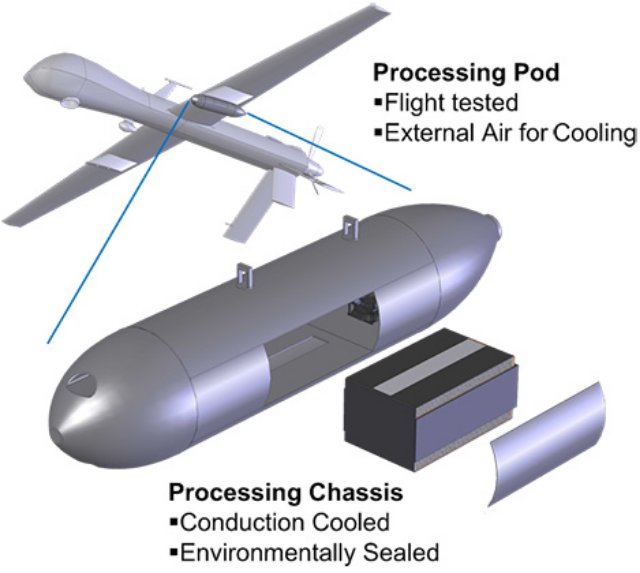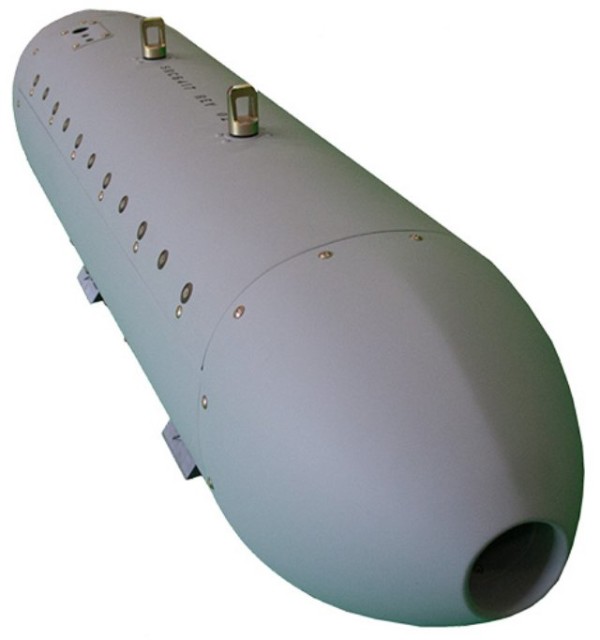
SRC has been focused on solving myriad problems that exist around the data analysis requirements of intelligence, surveillance and reconnaissance (ISR) missions. In an effort to bring big data analysis closer to the sensor, SRC has developed Agile Condor for the US Air Force Research Lab (AFRL) in Rome, NY. The Agile Condor pod system is a scalable, low cost, size, weight and power (low-CSWaP) hardware architecture that enables high-performance embedded computing (HPEC) on-board remotely piloted aircraft (RPA).
The Agile Condor flight-configured pod system consists of an external pod enclosure and an internal chassis that supports the use of commercial off-the-shelf (COTS) single-board computers (SBCs), graphics processing units (GPUs), Field-Programmable Gate Arrays (FPGAs), and solid-state storage devices (SSDs). The pod enclosure is based on an existing, flight-certified design specifically modified to use ambient air cooling for thermal management of the embedded electronics. The chassis utilizes a modular, distributed network of processors and co-processors based on open industry standards to deliver more than 7.5 teraflops of computational power at better than 15 gigaflops per watt. The COTS upgradeable architecture of the Agile Condor system provides for fast technology refresh, which decreases life cycle costs, reduces system downtime, and assures continued usefulness of the system.
“We are proud to have been given the opportunity to engineer an innovative and sophisticated computing architecture like the Agile Condor system for AFRL’s Information Directorate in Rome, NY. The delivery of this first system helps advance the intelligence, surveillance and reconnaissance capabilities of our Air Force, providing our national leaders and warfighters with significant technical, tactical, and situational-awareness advantages far beyond the present capabilities,” said Paul Tremont, SRC’s president and CEO. “We remain strong in our commitment to provide warfighters with increased actionable intelligence by pushing the boundaries of HPEC and bringing data processing and analysis capabilities closer to the edge.”

Top-Down View of the Agile Condor Pod
Onboard processing leads to efficiencies
The Agile Condor modular computing architecture addresses the limitations of processing, exploitation and dissemination (PED) associated with onboard sensors. Sensors have rapidly increased in fidelity, and are now able to collect vast quantities of data, which must be analyzed promptly to provide mission critical information. Currently data is either stored onboard RPAs and physically downloaded for review at end of mission, or the data is downloaded in-mission through a data link.
The current dissemination methods restrict mission objectives in a number of ways. Onboard data storage is restricted by strict size, weight and power (SWaP) limitations and once storage capacity is reached, the mission ends. Stored data also creates an unacceptable latency between data collection and analysis, as operators must wait for the RPA to return to base to review time sensitive data. In-mission data transfers, by contrast, can provide data more quickly, but this method requires more power and available bandwidth to send data. Bandwidth limits result in slower downloads of large data files, a clogged communications link and increased latency that could allow potential changes in intel between data collection and analysis. The quantities of data being collected are also so vast, that analysts are unable to fully review the data received to ensure actionable information is obtained.
Opening the door to future capabilities like neuromorphic computing
The modular design of the Agile Condor system’s architecture allows for expandable computational power – paving the way for advanced computing technology, such as neuromorphic computing. Bio-inspired technology like neuromorphic computers function in a similar way to the human brain and use very little power for certain tasks. This technology, when used on the Agile Condor system, allows for enhanced situational awareness, adaptive decision making, multi-mode, multi-mission, massive analytics and heterogeneous information processing, helping RPAs recognize and act upon real-time information. Additionally, due to the low power consumption of neuromorphic computers, RPAs would be able to stay in the air for longer durations – enabling new and more efficient missions.

Front View of the Agile Condor Pod
The Agile Condor pod system is able to use neuromorphic computing techniques to process data onboard and give operators more actionable, time sensitive data. In addition, the Agile Condor hardware, when coupled with SRC’s adaptable, distributed, portable Airborne Wide Area SAR Processing (AirWASP) software, can provide assisted autonomy to RPAs. In the future, the systems will facilitate the processing of data from multiple sensors and utilize machine learning capabilities to selectively queue sensors for particular scenarios. Instead of surveying large areas with all sensors, the RPA would conserve power by using only the sensors best equipped to detect anomalies over large areas. When a point of interest is detected, the RPA would then dynamically engage specialized sensors, like a camera, to collect more data and notify mission operators for further review and inspection. This selective “detect and notify” process frees up bandwidth and increases transfer speeds, while reducing latency between data collection and analysis. Real time pre-processing of data with the Agile Condor system also ensures that all data collected is reviewed quickly, increasing the speed and effectiveness with which operators are notified of actionable information.
The Air Force is scheduled to put the Agile Condor pod system through flight testing in the fall of 2016 as part of an ongoing, three-year research and development contract SRC has with AFRL to deliver a complete Agile Condor system with embedded computing at the end of 2017.
Source: Press Release
